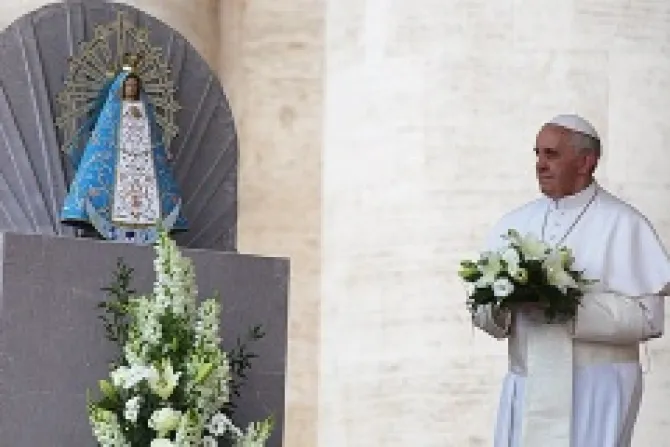Aug 15, 2013 / 23:07 pm
While visiting a convent of Poor Clare nuns yesterday, Pope Francis said that "a consecrated woman is a little like the Virgin Mary," one of the nuns related to Vatican Radio.
"Mary stands behind the door of Paradise. When the sinners get there, Saint Peter is not always opening the doors. Mary suffers, and remains there," Sister Maria Concetta said, recounting Pope Francis' words to the nuns of the Immaculate Conception Convent in Castel Gandolfo Aug. 15.
"During the night, when nobody can listen or hear, Mary opens the doors of Paradise, and lets everybody in."
While Roman Pontiffs have customarily spent August in Castel Gandolfo, Pope Francis has remained in Rome this month, traveling this morning to the resort town by helicopter to say Mass for yesterday's holy day of obligation.
Upon arriving in the town, Pope Francis went first to visit briefly the Poor Clares, whose monastery is located inside the Pontifical Villa. It is the second visit he had made to the monastery.
Sr. Maria Assunta, another of the nuns of the monastery, said that "Pope Francis invited us to deeply live our vocation and to be faithful to our charisms of simplicity and poverty that make us sisters."
The Poor Clares were founded in 1212 as a Franciscan order for women, by St. Francis and St. Clare of Assisi.
Pope Francis' predecessors had also visited the Poor Clares of Castel Gandolfo, and the community's relationship with the Bishop of Rome is a longstanding one.
Benedict XVI received them for an audience in the Apostolic Palace on Sept. 15, 2007, and encouraged them to be "bright torches of love, 'joined hands', watching in ceaseless prayer."
Blessed John Paul II said Mass at the monastery in the first year of his papacy, and entrusted himself and all of humanity to their prayers.
"In the troubled scenario of history you accompany humanity with your prayer," he told them. "Because of this presence of yours, hidden but authentic within society, and even more so within the Church, I also look with confidence to your joined hands."
Paul VI had met the Poor Clares on Sept. 3, 1971, and told them: "You, who are faithful to the Rule (of St. Clare), to life in community, to poverty, are a seed and a sign."
The link between Castel Gandolfo's Poor Clares and the Holy See goes back even further, however, extending to the 17th century. The monastery was entrusted to the community on March 18, 1631, when a Papal residence was established in the town.
During the next two centuries, wars and sieges at times obliged the nuns to become immersed in secular life, but their community did not break up.
The Holy See "ransomed" the monastery from Italy in the Lateran Treaty of 1929. This treaty recognized Vatican City as a sovereign state, and established the Papal residence in Castel Gandolfo as an extraterritorial property of the Vatican.
The Second World War turned the community's life upside-down. The monastery was bombed in February 1944, killing 18 nuns.
(Story continues below)
During the difficulties of the war, Sr. Maria Chiara of St. Therese of the Child Jesus came to be seen as a beacon of light for her dedication to her community. She left nothing undone in trying to alleviate the suffering of the bombing's survivors, and was devoted to her religious namesake.
Asking to suffer the same disease as St. Therese, she was diagnosed with tuberculosis and offered her death for the sanctification of priests. Her cause for canonization is open; she has already been recognized as being "heroic in virtue" and named a Venerable.



